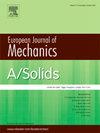Bending mechanics of biomimetic scale plates
IF 4.2
2区 工程技术
Q1 MECHANICS
引用次数: 0
Abstract
Dermal scale-inspired structures are a unique class of multi-material systems that can exhibit significant nonlinearity and evolving anisotropy, even in small strains. In this work, architecture–property relationships are derived for both synclastic and anticlastic curvatures of the plate using analytical modeling, finite elements, and experiments. The developed model outlines analytical relationships between geometry, deformation, and bending response of the system. The results show that, as the scales engage, both synclastic and anticlastic deformations show non-linear scale contact kinematics and cross-curvature sensitivity of moments, resulting in strong curvature-dependent elastic nonlinearity and emergent anisotropy. The anisotropy of bending rigidities and their evolution with curvatures are affected by both the direction and magnitude of bending, as well as scale geometry parameters, and their distribution on the substrate. Similar to earlier beam-like substrates, kinematic locked states were found to occur; however, their existence and evolution are also strongly determined by scale geometry and imposed cross-curvatures. This validated model helps us to quantify bending response, locking behavior, and their geometric dependence, paving the way for a deeper understanding of the nature of nonlinearity and anisotropy of these systems.
仿生尺度板的弯曲力学
皮肤尺度启发结构是一类独特的多材料系统,即使在小应变下也能表现出显著的非线性和不断发展的各向异性。在这项工作中,利用解析建模、有限元和实验推导出了板块共裂和反裂曲率的结构-性质关系。开发的模型概述了几何、变形和系统弯曲响应之间的分析关系。结果表明,当尺度啮合时,同裂变形和抗裂变形均表现出非线性尺度接触运动学和弯矩的交叉曲率敏感性,从而导致较强的曲率相关弹性非线性和涌现各向异性。弯曲刚度的各向异性及其随曲率的演化受弯曲方向、弯曲幅度、尺度几何参数及其在基体上的分布的影响。与早期的类梁基板类似,发现发生了运动学锁定状态;然而,它们的存在和演化也强烈地取决于尺度几何和施加的交叉曲率。该验证模型帮助我们量化弯曲响应、锁定行为及其几何依赖性,为深入了解这些系统的非线性和各向异性的本质铺平了道路。
本文章由计算机程序翻译,如有差异,请以英文原文为准。
求助全文
约1分钟内获得全文
求助全文
来源期刊
CiteScore
7.00
自引率
7.30%
发文量
275
审稿时长
48 days
期刊介绍:
The European Journal of Mechanics endash; A/Solids continues to publish articles in English in all areas of Solid Mechanics from the physical and mathematical basis to materials engineering, technological applications and methods of modern computational mechanics, both pure and applied research.

 求助内容:
求助内容: 应助结果提醒方式:
应助结果提醒方式:


